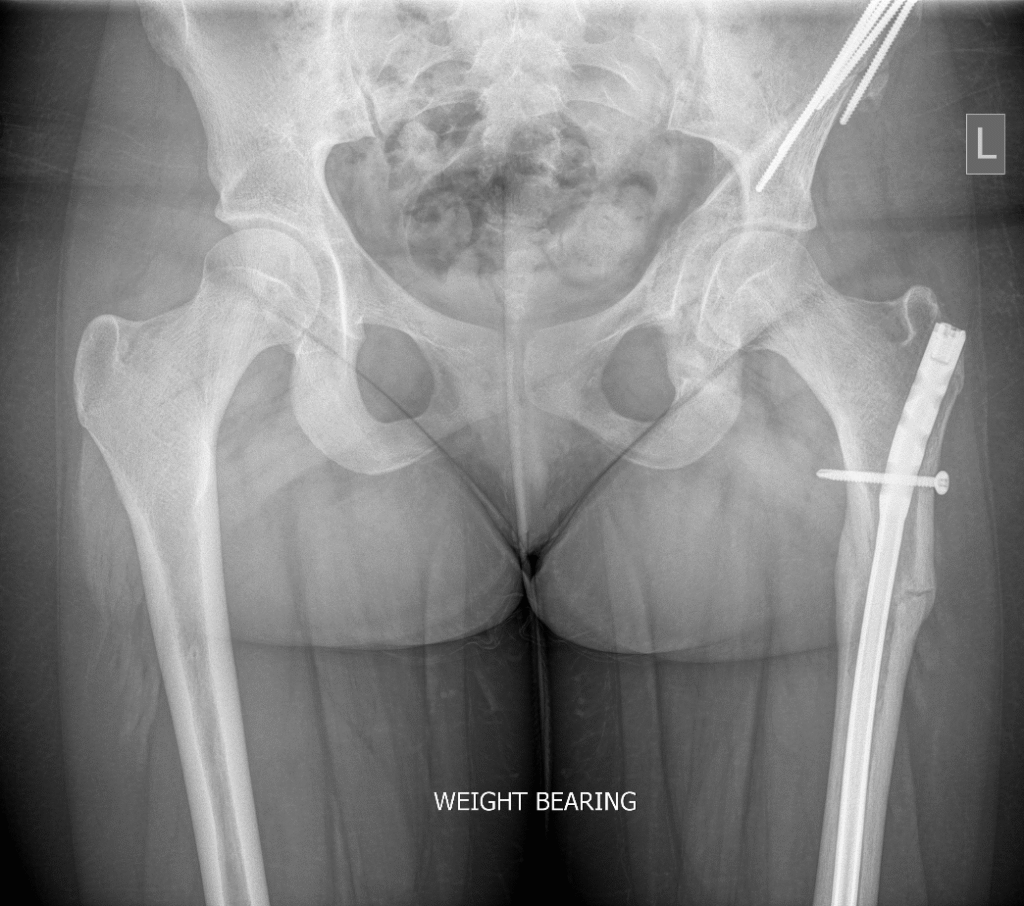Femoral Osteotomy
Correcting rotation. Relieving pain. Restoring natural movement.
Overview
A femoral derotation osteotomy is a surgical procedure used to correct abnormal rotation of the thigh bone (femur). In some people, the femur is twisted inwards (excessive anteversion) or outwards (retroversion), which can cause hip or knee pain, instability, difficulty walking, or problems with sports performance.
The operation involves cutting the femur, rotating it into the correct alignment, and securing it with a plate or rod to allow proper healing. By restoring normal alignment, the surgery improves the way the hip, knee, and leg work together, reducing pain and improving function.
The operation involves cutting the femur, rotating it into the correct alignment, and securing it with a plate or rod to allow proper healing. By restoring normal alignment, the surgery improves the way the hip, knee, and leg work together, reducing pain and improving function.
Example of Femoral Ostoeotomy

A partially united femoral osteotomy with intramedullary nail below a periacetabular osteotomy
Indications
This surgery may be recommended for:
Persistent hip, knee, or leg pain due to abnormal femoral rotation
Inward turning gait (“in-toeing”) or outward turning gait ("out-toeing") that causes tripping, fatigue, or cosmetic concerns
Patellofemoral problems (kneecap instability, maltracking) related to abnormal femoral torsion
Labral tears or hip impingement symptoms caused by malrotation
Failure of non-surgical treatments such as physiotherapy or bracing
Surgical Approach
Risks
As with any major bone surgery, potential risks include:
Infection
Bleeding or blood clots
Nerve or vessel injury (rare)
Nonunion or delayed bone healing
Malrotation (under- or over-correction)
Hardware irritation (often requiring later removal)
Stiffness or ongoing pain
Anaesthetic or general medical complications
Recovery Timeline
A typical recovery would be:
Hospital stay: 1-2 nights
Walking with a frame or crutches:
First 4 weeks
Return to driving: 4 weeks for a left femur, 6 weeks for a right femur Back to office work or light duties: 2 to 4 weeks
Full recovery and return to gentle sport: 3-6 months
Once the osteotomy has united, most patients acheive better hip and knee mechanics, reduced pain and improved gait, allowing them to return to the life you enjoy.
Once the osteotomy has united, most patients acheive better hip and knee mechanics, reduced pain and improved gait, allowing them to return to the life you enjoy.
Frequently Asked Questions
How do you know if my femur is rotated abnormally?
Clinical examination, gait assessment, and imaging such as CT scan are used to measure femoral version accurately.
Can this surgery be done on both legs?
Yes, if both femurs are rotated abnormally, surgery may be performed on one side at a time or, in some cases, both during the same admission.
Will I need the plate or rod removed later?
Occasionally the hardware can stay in permanently, but it's typically removed once the osteotomy has united (typically 12 months after the first procedure), before it has become too embedded within bone.
Is this the same as a hip replacement?
No. A derotation osteotomy preserves your natural hip joint by correcting bone alignment, rather than replacing the joint.
What is the success rate?
Most patients experience improved walking pattern, reduced pain, and better hip and knee function. Outcomes are best when surgery is carefully planned and combined with good rehab.
How soon will I notice improvement?
Many patients notice a straighter gait soon after surgery, but strength and function continue to improve for several months as the bone heals and muscles adapt.
Clinical examination, gait assessment, and imaging such as CT scan are used to measure femoral version accurately.
Can this surgery be done on both legs?
Yes, if both femurs are rotated abnormally, surgery may be performed on one side at a time or, in some cases, both during the same admission.
Will I need the plate or rod removed later?
Occasionally the hardware can stay in permanently, but it's typically removed once the osteotomy has united (typically 12 months after the first procedure), before it has become too embedded within bone.
Is this the same as a hip replacement?
No. A derotation osteotomy preserves your natural hip joint by correcting bone alignment, rather than replacing the joint.
What is the success rate?
Most patients experience improved walking pattern, reduced pain, and better hip and knee function. Outcomes are best when surgery is carefully planned and combined with good rehab.
How soon will I notice improvement?
Many patients notice a straighter gait soon after surgery, but strength and function continue to improve for several months as the bone heals and muscles adapt.
Ready to Learn More?
If hip pain is holding you back, I’d be happy to meet with you to assess your symptoms, review your imaging, and discuss whether a hip replacement is the right solution. Together, we’ll tailor a plan that suits your lifestyle, goals, and long-term joint health.
